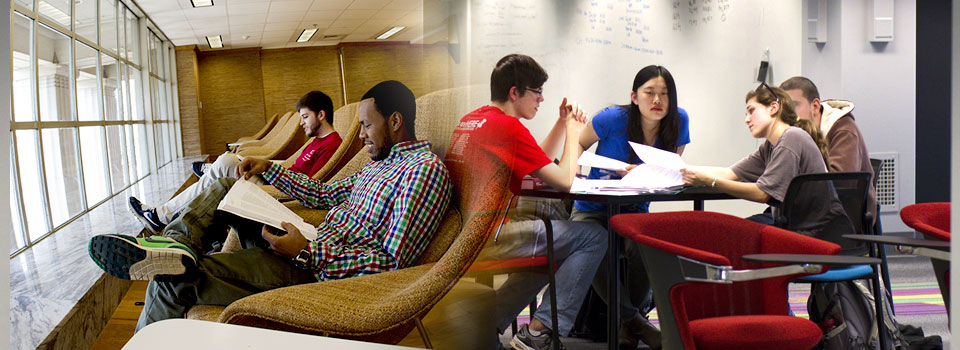On the fourth floor of the main library, students are discussing their marketing homework, drawing carbon chains on the walls and jotting down a poem on a door-and while it’s not typical library behavior, it’s all encouraged.
In January, the main library opened two new study areas, and part of the fourth floor is designed to be a collaborative study space, where students can talk or silently read a textbook. Many of the walls are covered in dry-erase boards or are coated in chalkboard paint so students can work out math problems or practice Korean characters. If that wasn’t enough surfaces for students, there are 12 movable dry-erase boards each standing 6 feet tall.
The space totals 12,000 square feet. The carpet is bright turquoise and lime. Desks and tables-all movable and on wheels-are scattered throughout. The walls are dotted with dozens of power outlets, and every column has an outlet for a laptop, tablet or mobile phone.
“There’s a demand for more places for students to study-especially to study in groups and have access to writing surfaces and power outlets,” said Bill Potter, university librarian and associate provost, who oversaw the project.
In 2012, when the library had offices and archives moved to the Richard B. Russell Building Special Collections Libraries and other locations, the space wasn’t yet needed for additional shelving, and it was turned into a student study area.
Potter estimates that hundreds of students come and go from the study area throughout the day. He sees more groups in the evening, but students come and go between classes during the day as well.
When the room is fully furnished, it will seat 400. For now, Potter said he’s waiting to see what furniture the students use so he knows what to order more of. As he walks through the space, he points out the counter height tables and notes that the students tend to seek out corners to study in.
Brandon Laudick, a junior accounting major, recently visited the fourth-floor study area to work on a group project for an introductory tax class. He’s since been back several times to work out accounting problems on the boards.
“It really helps to see the problem in its entirety on a wall instead of on a couple pieces of paper,” he said.
He said the study area’s walls are interesting.
“I’m always impressed to see what other students are working on when they leave different equations or problems on the board,” Laudick said. “It’s a solid visualization of the hard work students put into studying.”
The other new student study room is located on the third floor where the Hargrett Rare Book and Manuscript Library reading room used to be, near the offices of the UGA Press.
It’s a quiet study area where food and drink aren’t allowed. The 1,500-square-foot room features wood floors, several tables, two couches and a large window overlooking North Campus. Most of the furniture in the room-and outside the area-is original from the library’s opening in 1953. The couches and chairs were restored. The other furniture-Eero Saarinen womb chairs by the window and the Saarinen side chairs around the table-are new but were designed in the 1950s. Even the grass cloth on the wall is a reminder of the way the room first looked.
Both renovations took about six months.
And while libraries are changing and becoming more digital, Potter said that the library is more than a place to borrow books.
“The library always has been a place to learn and study,” he said.
